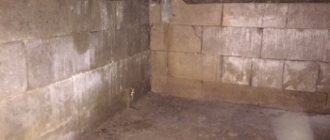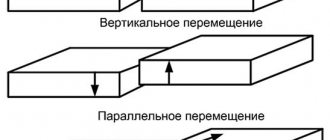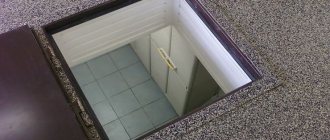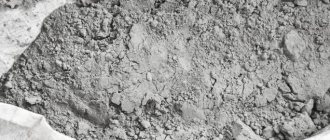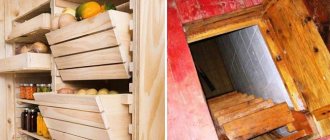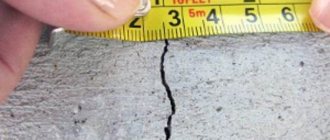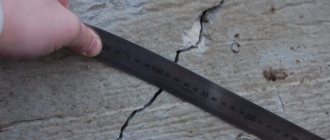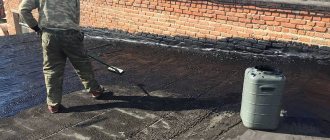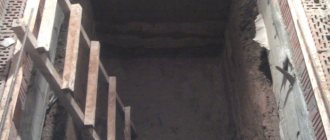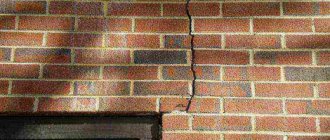Mold in the basement or cellar, similar to cotton wool, can often be found.
This is due to high humidity and poor ventilation. Many people no longer pay attention to mold in the basement and cellar. And in vain, because disgusting stains on the walls and ceiling not only spoil the appearance, but can also cause enormous damage to human health. In addition, food stored in the cellar suffers from this. White mold in the basement can spread to any other items and multiply very actively, which greatly reduces the shelf life of products. If white mold is found in the basement like cotton wool , you should definitely start destroying it. This article will help you do this correctly to make it impossible for the white mold parasite to reappear.
What is mold
Fungal colonies that develop from spores are called mold. Its spores almost constantly float in the air, and only under the influence of various unfavorable factors do they “wake up” and begin to actively reproduce. Fungi can grow on wood, concrete or paint. Currently, there are different types of mold. Depending on this, there are spots that look like cotton wool in black, brown, white and green. There are also glowing fungi, but they are not dangerous for basement walls.
White mold can easily destroy finishing and building materials, often even reaching the base. In this regard, owners of mold in the basement should think about getting rid of this parasite as soon as possible, otherwise they will have to do a full-fledged renovation, or even a rebuild. There are black, brown and white mold. Its color depends both on the type of fungus and on the stage of development, as well as the color of the surface where the parasite has settled.
Technologies for treating concrete from dust
First, it is advisable to consider the method of adding toppings. The technology is not simple, it requires professional work and the use of special equipment. The slightest mistakes will lead to deformations and defects, that is, to peeling of the finished layer. Repairing the systems is impractical; it is easier to immediately remove everything that has been done and fill in a new screed.
According to the technology, the strength of the screed should not be lower than M300, the thickness should be from 70 mm and above; proper reinforcement and treatment with a vibrating screed are required . The hardener is evenly applied to freshly set concrete and rubbed in using concrete finishing machines. For proper distribution of the mixture, dosing carts are used.
When full initial setting is achieved, the shoe mark does not fall deeper than 4-5 mm - this is a signal to start topping
Operating principle:
- After pouring concrete, a technological break of 7 hours is required. To determine the readiness of the base for work, visual inspection is necessary;
- exactly 2/3 of the total volume of the hardener is distributed over the surface by dosing carts, starting from the abutments (walls, columns, doorways);
- Grouting begins when the composition is saturated with concrete moisture. Additional moistening is unacceptable - this is a serious violation of technology leading to defects;
- when primary processing is completed, the remainder (1/3) is added without pause. When the material is saturated, the second grouting is carried out;
- finishing is carried out when deep setting is achieved. This can be easily determined by visual inspection - the footprint of the shoe should not sink into the concrete deeper than 1 mm. Practice shows that 2 hours is enough for this. They work with grinding blades, smoothly changing the angle of inclination;
- when the concrete acquires a characteristic matte shine, the grouting is stopped and treated with sealers or curings;
- after 24-48 hours, the seams are cut and filled with polyurethane sealants.
Causes of Fluffy White Mold
- Clogged or missing ventilation shafts. Lack of air supply contributes to further mold contamination of the walls.
- Storing rotten vegetables and fruits. Such products are sources of mold.
- Use of wood products that are infected with fungus.
- Increased air humidity, constant accumulation of condensation. As a rule, this aspect depends on the first factor.
- Poor indoor air circulation.
Depending on the size of the fungal colonies, the methods of controlling parasites also differ. Without eliminating the unfavorable factor, it will be very problematic to protect the integrity of the premises and human health.
Features of antiseptics
Aqueous anti-mold solutions easily penetrate into the porous structures of concrete; most of them are odorless, non-toxic and non-flammable. This makes them suitable for interior finishing work. However, they are easily washed out of external structures over time, so the protection has to be updated more often. They contain mineral salts that cause metal corrosion, so it is better not to use them with reinforced concrete. One of the popular solutions, Gambit Antiseptic (N-5), is consumed from approximately 0.1 to 0.3 l/m2.
Substances containing organic solvents penetrate into concrete, brick, and tiles even more effectively. However, toxic fumes require the use of safety regulations with such solutions and limit their use indoors. Protection of external concrete finishes and foundations with these solutions is in great demand, since they are neutral to metal reinforcement. Mold disappears for a long time. One of the most effective mold eliminaters in this category is “Nortex”; 160 g/m2 is used on an infected surface, and 80 g/m2 for prevention.
Anti-mold oil solutions are intended for non-residential premises with high humidity (basements). They are not washed out of concrete for a long time and reliably protect it from harmful microorganisms and fungi. Their use limits toxicity and flammability, so it is not recommended to use them on concrete and plaster near boilers and furnaces. To protect external structures (basement, foundation), an antiseptic of this type is well used - Belinka, with a consumption of 1 liter per 5-10 m2.
Combined chemical compositions consist of several active poisons, combined in one container using complex technology. They are the fastest and most effective against all types of fungi and other microorganisms. For example, one of the most powerful liquid concentrates, Ceresit CT-99, is diluted with water according to the manufacturer’s recommendations and applied to plaster or painted walls at a consumption of 30 to 90 g/m2.
The consumption of the selected antiseptic option for concrete depends on the quality of the surface, the porosity of the concrete stone, the degree of mold infection and the purpose: for the prevention or destruction of microorganisms. More substances are spent on exterminating parasites. Carefully following the manufacturer's recommendations will give the expected result and the plastered walls of the apartment will look well-groomed.
Favorable conditions for fungal growth
For white mold to appear in a basement or cellar, specific conditions are required:
- Presence of spores in the air. They are transported and easily settle in the cellar on animals, products and people.
- Nutritious organic medium (wood, soil, paper or peat pots).
- Favorable microclimate (temperature about 20 degrees and high humidity). In addition, non-functioning or poor-quality ventilation in the house has a bad effect.
Certain varieties of white mold reproduce even at temperatures of 0 degrees.
It is important to pay attention to the ventilation system in the house. Normal and constant air movement prevents white mold spores from attaching to any surface. In the corners, air movement is very difficult; this is where, as a rule, colonies of hated fungi accumulate.
Ventilation removes excess moisture from the room that occurs due to too high humidity outside or a large difference in temperature. If there are fungal spores on the walls of the cellar or basement, but there are no normal conditions for reproduction, they will not even germinate. Thus, poor ventilation is a key reason for the appearance of white mold in the basement and cellar.
We carry out prevention
Agree, it is always easier and cheaper not to eliminate the problem, but to prevent it. Therefore, it is necessary to periodically prevent the appearance of black mold in the house. Such measures include:
- regular ventilation;
- checking the proper operation of ventilation;
- checking the premises for fistulas, leaks, cracks and eliminating them;
- treating all existing building materials with special antiseptic agents (before repairs);
- eliminating holes and cracks in frames, if any;
- ventilation of the bathroom.
Fans for the bathroom
Important! Don't dry things in the bathroom!
Black mold is a dangerous enemy of humans, causing great harm to health. It is possible and necessary to fight it, but it is best not to start the problem and start solving it at a very early stage. Then victory will definitely be on your side.
White mold in the basement is dangerous for humans
Many people do not even know that white mold on walls poses a great danger not only to building materials, but also to human health and life. A ceiling or floor (especially a wooden one) affected by fungus can easily cause serious injury. , white mold in the cellar human health as follows:
- Through direct contact with the skin.
- Human circulatory and respiratory system.
- Eating foods affected by white mold.
White mold spores are toxic and multiply quite quickly. In this regard, when spores enter the human body, various diseases can develop.
Unpleasant consequences of contact with fungus:
- A variety of skin diseases that occur against the background of allergic reactions (so-called mycoses).
- Stomach upsets, attacks of nausea, vomiting, and digestive problems.
- Anemia and general exhaustion of the body.
- Diseases of the upper respiratory tract (sinusitis, severe runny nose, nosebleeds, difficulty breathing).
- Headaches and dizziness.
Long-term influence of the fungus on the human body can lead to pathologies of the kidneys and liver. In some cases, internal bleeding and emphysema occur. The risk group includes children, elderly patients, and people with weak immune systems.
White mold in cellars and basements how to fight
Having learned the main reasons for the appearance of white mold, it’s time to figure out how to get rid of white mold in the cellar .
Today there are three effective methods that make it easy to remove it from any room. Including from the basement or cellar. In addition to them, there are various chemical preparations and all sorts of folk recipes against fungus. The vast majority of these methods involve major repairs in the basement and are only required when the situation is too advanced. If the areas covered by the parasite are small and the risk of its reappearance is quite small, then special preventive techniques can be used. The most popular solution today is based on 250 ml of 40% formaldehyde and 10 liters of water. Apply it to the affected areas, and after complete drying, re-plaster and whitewash the ceiling and walls. If there is good ventilation in the room, then the fungus will no longer bother you.
More details about the methods below.
XILIX GEL guarantee against bugs and mold for 10 years!
HOW XILIX GEL CURATIF FONGI PLUS WORKS
XILIX® Gel is an innovative development for combating any wood pests such as longhorned beetles, borers, shashel, wood borers, etc. It is also an effective professional biocide that effectively destroys mold, mildew, and copes with wood rot and defects.
Indispensable for the prevention and treatment of wooden structures.
• Destroys termites, borer beetles, bark beetles, wood borers, longhorned beetles, has FUNGICIDAL properties, etc. • Economical and easy to use • Safe for people • Strengthens the structure of the wood • Ready to use, the gel does not flow, leaves no traces • Penetrates deeply into the wood
XILIX® Gel is an excellent, safe alternative to phosphine gas fumigation
with a 10 YEAR warranty! High efficiency is achieved thanks to properly selected gel components.
Biocides and permethrin in the composition give a fantastic insecticidal and fungicidal effect. Thanks to its thixotropic formulation, the gel works without loss of properties even in a thick layer of wood, thereby reducing the number of applications to obtain the required therapeutic or prophylactic dose of the gel.
Prevention
Treatment
Treating concrete with mastic
Turning to the issue of waterproofing, it is advisable to consider the possibility of treating concrete bases with mastics. Compositions of this group are used to protect concrete surfaces, reinforced concrete structures and structures, wells, balconies, bathrooms, under screed .
First of all, you need to be puzzled by the choice of coating waterproofing. The leading positions are still occupied by bitumen-based materials. On their basis, single- and multi-layer coatings with a thickness of 1 mm or more are created.
As a result, a film layer is formed that protects the artificial stone from moisture and water, acids and alkalis. Under conditions of high loads, it is advisable to pay attention to bitumen mastics modified with polymers. This way the structure will last ten years longer, successfully coping with the expected loads. In general, bitumen mastics perform well when used outdoors .
For interior work, it is advisable to involve:
- cement - prepared by mixing the dry mixture with water. The resulting paste (dispersion) is applied to the concrete with a brush and hardens into a hard waterproofing layer. The finished coating is resistant to groundwater pressure, which is important for buried structures, in basements, and tanks;
- polymer-cement – formed when mixing a dry mixture with special synthetic elasticizers. The ready-to-use material is a paste-like mass, which, upon completion of curing, retains a rubber-like structure and elasticity. Polymer cement mastics have a high degree of adhesion to concrete. Application is carried out in 2-3 working approaches. This material is effective on substrates where there is a risk of cracking and temperature changes (open terraces, balconies, heated floors);
- polymer mastics are aqueous dispersions of synthetic resins + fillers. The material is effective in protecting wet rooms, but is not used under constant water load (swimming pools, showers with a drain on the floor).
In addition, mastics are usually classified into one-component and two-component . The first ones are made on the basis of solvents and harden under the influence of air moisture, forming a solid, homogeneous layer. Two-component - do not contain solvents, are more elastic due to the content of latex or other polymers, and contain technological additives. A protective coating with such materials is formed in a matter of seconds.
Advantages of mastics for waterproofing:
- high elasticity;
- excellent adhesion to concrete;
- mastics form a uniform, seamless waterproofing coating;
- some varieties can be applied to wet concrete;
- wide operating temperature range.
By spraying mastics using a mechanized method, you can treat up to 800 sq.m. per shift. areas
Principle of applying material to concrete:
- The surface should be cleaned of dirt, loose, flaking layers. Remove weak concrete, cement laitance, and petroleum products. For work, use high-pressure apparatus (water jet, sandblast (wet method));
- all detected defects and visible cracks are expanded and eliminated using repair compounds;
- mates and corners are rounded;
- the material is prepared for application. One-component mixtures are brought to homogeneity, two-component mixtures are mixed in accordance with the manufacturer’s recommendation (if manual application is implied);
- The recommended method of application is mechanized. This will allow you to quickly process large areas. For this purpose, airless spray units are used. Two-component mastics are mixed using special devices immediately at the time of application and form a coating;
- When applied manually, brushes are used.
If the mastic is applied manually, the minimum thickness of application on horizontal surfaces is 1 mm, on vertical surfaces – 0.5 mm. When sprayed in one pass, a coating thickness of 3 mm can be formed.
On critical structures, it is advisable to turn to penetrating waterproofing . Such materials are able to penetrate the pores and capillaries of artificial stone, increasing the strength characteristics and waterproof parameters, while maintaining the vapor permeability that is beneficial to the health of concrete.
It is necessary to remember about insulation of seams and butt joints. Elastic tapes can be used for this; they are embedded in a layer of fresh waterproofing. An alternative option may be polymer sealants. Tapes are recommended for use in areas with a high risk of leaks, as they are elastic, waterproof, and tear-resistant material. Under conditions of water loads, structural joints can be protected with swelling pastes and tapes, and polyurethane sealants.
How to get rid of white mold in the basement: microwave method
Professionals use microwave radiation to treat mold, which allows them to heat the infected room to a temperature of more than 60 degrees Celsius. The fungus grows in cool, damp environments and is quickly killed by too high temperatures.
The microwave installation perfectly dries not only concrete walls, but also wood.
It may seem that this method is very simple, but in fact it is impossible to apply it yourself, without special equipment and appropriate skills. Professionals use microwaves to measure the heating temperature of a room using laser pyrometers, since in this situation a regular thermometer, unfortunately, will not give an accurate result.
Using a microwave to clean white mold from a cellar or basement has many advantages:
- With this method, there is no need to use chemicals, which significantly reduces the possible occurrence of negative consequences for human health and life. The method is 100% harmless for the owner of the premises.
- Microwave radiation makes it possible to get rid of mold both outside and inside, that is, directly in the material at a depth of up to 30 cm. Microwave rays, heating the cellar or basement, completely destroy the mycelium of the fungus, completely eliminating its reappearance.
- Microwave radiation propagates through any and any surfaces, be it concrete, brick, plastic or even metal.
- Microwave radiation allows you to treat a room even in very hard-to-reach places, where treatment with chemicals is simply impossible.
Why is it necessary to eliminate dust?
Dust formation is a problem with any concrete floors and the need for additional treatment is dictated by practice. You should not rely on the fact that the monolithic surface will not start collecting dust. Such phenomena are caused by the chemical composition and structure of artificial stone and affect almost any object if the surface has not undergone additional processing.
Eliminating this negative factor has many advantages:
- easier cleaning;
- stopping surface erosion;
- protection of deep and upper layers of foundations;
- increase in service life;
- aesthetic appearance;
- productive work of equipment and personnel.
The main methods for treating concrete from dust consist of surface hardening with topping, impregnation, and grinding. The most common method of dust removal is the introduction of dry hardeners, but this method only works on new and durable concrete (not lower than M300) .
If the base is old and less durable, it makes sense to resort to grinding and the subsequent introduction of special impregnations. Such materials additionally compact concrete and improve the quality of its operation.
